Understanding Soft Cones for Cats: A Complete Guide


Intro
In a world where furry companions seek comfort, pet owners often face the challenge of helping their cats during recovery from procedures or simply providing a safe environment for healing. Among the solutions available, soft cones stand out as an increasingly popular choice. Unlike their rigid counterparts, traditional Elizabethan collars, soft cones offer a gentler touch, accommodating a feline's natural behaviors while ensuring they don't harm themselves.
This article is intended to dig deep into the realm of soft cones for cats. It will cover various aspects, like the contrasting comfort levels compared to hard collars, the different sizes that cater to every fluffy nuance, and recommendations based on user stories. Furthermore, we’ll look into how these cones play a significant role in post-surgery recovery and overall feline well-being. For pet owners, this guide presents valuable insights, paving the way for informed decisions on caring for their beloved pets.
Let’s start by examining the crucial role of pet care and grooming in maintaining your cat's health.
Prologue to Soft Cones for Cats
When it comes to caring for a pet, the smallest details often have the biggest impact. One such detail is the choice of recovery aid after surgery or injury, particularly soft cones for cats. These gentle, fabric-based alternatives to the traditional hard plastic Elizabethan collars offer a host of benefits for both the cat and its owner. Understanding what they are and how they can make a difference in your feline's recovery journey is paramount.
Definition of Soft Cones
Soft cones, often referred to as recovery collars or E-collars, are designed to prevent cats from licking or biting at their wounds while still allowing movement and comfort. Unlike the classic, rigid cone which can often feel like a torture device for a cat, soft cones are made out of soft, padded materials. They might resemble a small pillow or a flexible tube that can adjust to the cat's head size. The primary function of soft cones is protective—keeping cats from aggravating a healing injury while being less intrusive in their daily lives.
The availability of soft cones has increased with a rising understanding of pet comfort. They come in various styles, extents, and colors, catering to the needs of discerning cat owners who seek functionality without compromising on an animal’s well-being. The modern soft cone can be an eye-catching accessory or a simple, utilitarian design with one goal: to aid in recovery.
The Evolution of Pet Recovery Aids
The journey of pet recovery aids has seen significant changes over the years, evolving from basic solutions to highly specialized products. In the past, pet owners often resorted to makeshift solutions such as using old t-shirts or sweaters to prevent their cats from accessing wounds. While resourceful, these early methods lacked effectiveness and could lead to compromising the healing process.
Over time, the need for more effective and comfortable solutions became apparent. Traditional hard cones, while serving their purpose, often led to frustration for both cats and their owners. As veterinary science advanced, so did the understanding of animal behavior and comfort. Soft cones emerged as a revolutionary option, designed with a pet's comfort in mind, minimizing anxiety and promoting a positive recovery experience.
"Soft cones represent a shift in our approach to recovery; they recognize that pets, like people, experience discomfort and stress during healing, and strive to mitigate that."
Today’s soft cones embody material innovations and design improvements that prioritize the health and happiness of pets. They are not merely a tool for restraint but rather a thoughtful enhancement to the recovery process, focusing on the overall well-being of our feline friends. This transition is rooted in a growing awareness that recovery can be more effective when pets feel secure, unencumbered, and at ease.
Benefits of Soft Cones Over Traditional Collars
Cats, being creatures of comfort, often find traditional collars limiting. Soft cones have emerged as an essential alternative. More than just a trend in pet recovery aids, these soft cones provide a multitude of benefits that can significantly improve a cat’s post-operative or recovery experience.
Enhanced Comfort for Cats
Soft cones are designed with a focus on comfort. Unlike the rigid Elizabethan collars that can feel like wearing a helmet made out of bricks, soft cones are padded and lightweight. For instance, think of it this way: imagine wearing an uncomfortable armchair around your neck versus a comfy cotton scarf. The soft cone allows for a wider range of motion and doesn’t irritate the skin or fur.
Additionally, many soft cones come with adjustable straps, making it easy to achieve a snug yet gentle fit. Thus, the cat doesn't experience constant pressure or friction which is often associated with traditional cones. By allowing your cat the freedom to turn its head comfortably, the risk of stress-induced behaviors—such as anxious scratching or biting— is significantly lessened.
Reduced Anxiety and Stress
For many cats, wearing a traditional cone can evoke feelings of distress. They might feel trapped, clumsy, or unable to navigate their environment comfortably. Soft cones, on the other hand, can help reduce stress significantly.
Imagine a cat trying to navigate its territory while bumping into walls and furniture due to a rigid plastic collar. It's easy to see how that could frustrate a feline that values its independence. In contrast, soft cones are less intrusive. They conform better to a cat's natural movements, enabling them to groom themselves without feeling hindered.
This can lead to a calmer cat throughout the recovery process. Some pet owners have noted that their cats adjusted to wearing soft cones much more willingly and even relaxed while wearing them. Ultimately, reducing anxiety and promoting a sense of security is something every pet owner should prioritize during recovery.
Improved Mobility and Visibility
In a world where agility is key for cats, their mobility shouldn't be compromised. Traditional cones often create blind spots and limit a cat's ability to see its surroundings, leading to more bumps and bruises.
Soft cones tend to be more streamlined and lightweight. They don’t obstruct the cat's peripheral vision as much as traditional models, allowing for natural observation of their environment. For example, a cat wearing a soft cone can still perch on a windowsill, watching birds outside without losing its balance or footing.
"Cats are naturally curious creatures. It's crucial to ensure that any recovery aid allows them the freedom to explore and interact with their environment, enhancing their overall well-being."
Furthermore, many soft cones are designed with an array of vibrant patterns or colors, adding a bit of flair to the typical post-surgery regimen. This means that instead of a bulky, clear plastic cone dominating their appearance, your kitty can sport a dainty polka dot design while recovering, providing a sense of well-being and normalcy.
In essence, the benefits of soft cones represent a leap forward in the world of pet care. They offer comfort, diminish anxiety, and allow more freedom of movement. For anyone who’s ever witnessed their beloved feline struggling with a traditional collar, opting for a soft cone could make all the difference in the recovery experience.
Choosing the Right Soft Cone
Finding the right soft cone for your cat is more than just a matter of preference; it’s a crucial aspect of their recovery and general well-being. The selection process is multifaceted, intertwining comfort, safety, and functionality. With different sizes and styles available, knowing how to navigate this array is essential for every cat owner. A well-chosen soft cone can ease your cat's recovery while minimizing distress.
Assessing Size and Fit
Selecting an appropriately sized soft cone is vital. An ill-fitting cone can cause discomfort or even impede your cat’s mobility. To assess the right size:
- Measure Your Cat's Neck: Use a soft measuring tape to determine the circumference of your cat’s neck. This provides a baseline for cone size.
- Check the Length: The cone should extend just far enough to prevent your cat from reaching areas they might lick or scratch. Generally, cones need to be long enough to discourage access to injuries but not so long that they hinder movement.
- Consider the Shape: Soft cones often come in various shapes. Some are wider at the base, providing a more secure fit, while others may taper. Ensure the cone won’t easily slip off or rub against your cat’s chin or neck.
The right size contributes not only to comfort but also to effective recovery. Remember, a snug fit around the edges can prevent escape attempts.
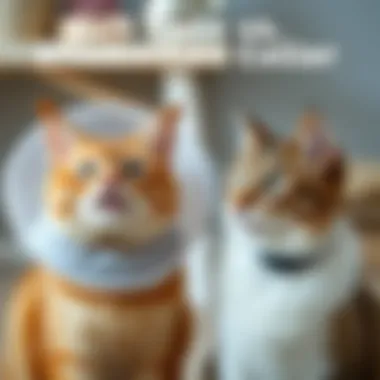
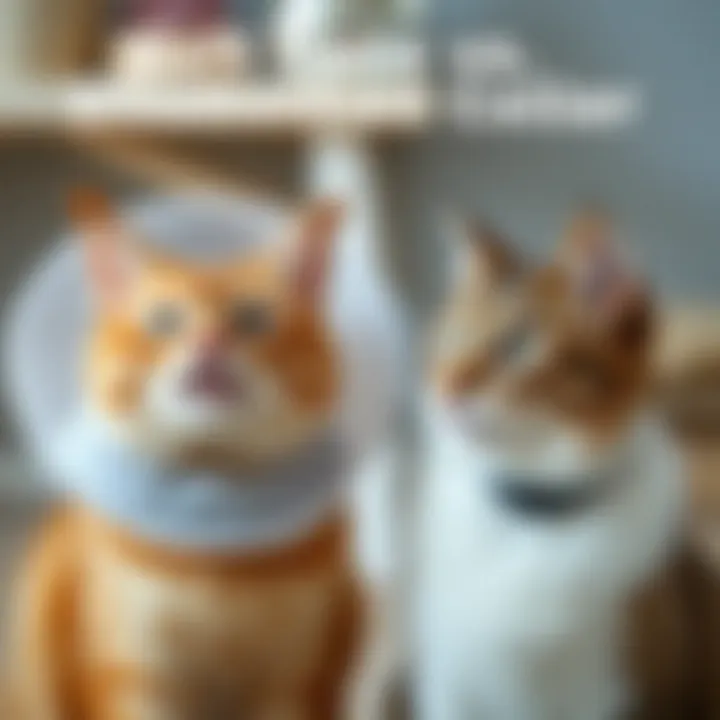
Material Considerations
The material of the soft cone affects both comfort and durability. Here are key points to think about:
- Breathable Fabrics: Soft cones made from breathable materials can prevent overheating, reducing discomfort. Look for cotton or mesh fabrics.
- Washability: Recovery can be messy. Select a soft cone that’s machine washable or easy to wipe down. This simplifies upkeep and keeps it hygienic.
- Quality and Durability: Not all soft cones are created equal. Invest in a higher-quality option that won't wear thin or tear easily. A sturdy cone should withstand your cat’s day-to-day activities without falling apart.
Balancing comfort with practicality involves considering how well the cone will hold up under your cat’s antics.
Style Variations: Which is Best?
Soft cones come in a variety of styles, each with its own advantages. Choosing the right one depends on your cat’s personality and condition. Here are popular styles:
- Padded Soft Cones: These offer extra cushioning and comfort, ideal for sensitive cats.
- Inflatable Collars: Similar to a neck pillow, these provide excellent freedom of movement while still preventing access to wounds.
- Colorful and Fun Designs: Some cones come in vibrant colors or patterns. While they won’t affect functionality, they can help lift the mood of both you and your pet.
To decide which is best, observe how your cat behaves. A more adventurous pet might benefit from an inflatable collar, while a sensitive one could prefer padding.
"Choosing the right soft cone is about balancing comfort and effectiveness. Look closely at fit, materials, and styles to find one that suits your cat's needs."
In summary, picking the right soft cone for your cat requires careful thought. Assessing size and fit, considering material choices, and evaluating style options will lead to a better recovery experience for your furry friend.
Soft Cone Care and Maintenance
Taking good care of a soft cone is vital for ensuring that your cat can recover comfortably and effectively. A soft cone serves its purpose in preventing a cat from reaching their healing wounds or irritated areas, but the care you provide can enhance its effectiveness and prolong its lifespan. In this section, we will delve into two key areas: cleaning the soft cones properly and assessing their wear and tear.
Cleaning Soft Cones Effectively
Regular cleaning of a soft cone is necessary to maintain hygiene, especially after surgery or if it comes into contact with food, water, or litter. Bacteria can be lurking in all sorts of nooks and crannies, just waiting to cause a problem for your furry friend. Here are some essential tips for keeping the soft cone spick and span:
- Use Mild Soap: When cleaning, opt for a gentle, pet-safe soap. Harsh chemicals can irritate your cat's skin, so keep it simple.
- Warm Water Rinse: Always use warm water for rinsing—this helps to dissolve any food particles or debris more effectively.
- Spot Clean Regularly: If there are noticeable stains or spots, take a damp cloth to clean these areas regularly instead of waiting for a full wash.
- Air Dry Completely: After washing, ensure that the cone is completely dry before putting it back on your cat. A damp cone could lead to discomfort or skin infections.
- Periodic Deep Cleaning: Depending on the frequency of use, consider giving the soft cone a deep clean weekly. This involves soaking it in warm soapy water and scrubbing it gently with a soft brush.
"A clean cone can mean the difference between a smooth recovery and a skin irritation battle that no pet owner wants to face."
Assessing Wear and Tear
Just like any other pet accessory, soft cones undergo wear and tear over time. Regular checks are necessary to ensure that it remains functional and safe for your cat. Here are some signs to look for and considerations to keep in mind:
- Inspect for Damage: Look for signs of fraying, tears, or any deformities. Even small damage can impact how well the cone stays on and protects your pet.
- Check the Fastening Straps: The straps should fit securely without being too tight. Ensure they are intact; broken straps could lead to the cone falling off, defeating its purpose.
- Surface Condition: Ensure that the soft fabric is still comfortable. If it starts feeling rough or hard, it may cause discomfort to your cat.
- Fit Over Time: As cats heal, their necks can change sizes. Make sure to reassess whether the cone still fits properly as your cat recovers.
- Replace When Necessary: If you notice any signs of wear, like a strong odor, or if the cone has been significantly altered from its original shape, it might be time for a new one.
By keeping an eye on these details, you can provide your cat with the comfort and protection needed for a successful recovery. This attention to detail shows your commitment to their well-being and can make all the difference in their healing process.
User Experiences and Testimonials
The perspectives of pet owners who have used soft cones for their cats offer valuable insights. Often, their stories provide a real-world lens through which we can examine how these recovery aids impact our feline friends. Personal experiences may highlight nuances that aren’t immediately apparent in products’ descriptions or technical specifications. Thus, featuring these testimonials is crucial for prospective users looking to understand the product’s practical application in daily life.
Understanding the feedback from users can help illuminate the effectiveness of soft cones and help in making a thoughtful decision. Cats, being creatures of habit, often react in varied ways to changes in their environment, especially when it involves a new accessory the likes of a recovery cone.
Common Feedback on Soft Cones
When pet owners share their experiences with soft cones, the feedback usually revolves around several common themes. Key aspects include comfort, adaptation, and long-term use. Here are some points that frequently pop up in discussions:
- Comfort Levels: Many pet owners report that cats seem much more comfortable in soft cones compared to traditional rigid ones. Some cats can sleep curled up without feeling constricted, thanks to the flexible design.
- Ease of Use: Owners have pointed out that soft cones are easier to put on and take off, which can be a relief after a long day caring for a recovering pet.
- Reduced Anxiety: Users often mention that their cats appear less anxious and more relaxed when wearing a soft cone, making post-surgery recovery smoother. Some have even noted that their cats engage in more playful behavior sooner than they did with older models.
Adopting a conversational tone in these experiences adds a relatable quality that resonates with others.
Successful Case Studies After Surgery
The success stories shared by users following post-surgery applications of soft cones provide hope and informed validation for potential buyers. Here's a look at some notable cases:
- Case of Bella the Tabby: After spaying, Bella's owner decided on a soft cone after hearing rave reviews. Her owner described how Bella adjusted within hours, displaying less stress compared to previous experiences. Bella was able to eat, sleep, and even play within days of her surgery.
- Max the Siamese: Max underwent a minor procedure and had a rough recovery with a standard collar in the past. Owner feedback revealed that after opting for a soft cone this time, he adapted quickly and showed no irritation. His owner found this immensely beneficial for a positive recovery experience.
- Luna’s Unexpected Journey: Luna, a rescue cat, was timid and easily frightened. Post-spaying, her owner chose a soft cone to keep her wounds safe. Surprisingly, Luna adjusted remarkably well, with her owner noting that she became less withdrawn and returned to her normal, curious self much quicker than expected.
These testimonials underscore how soft cones can facilitate a smoother recovery process for cats, easing owners' minds as their pets navigate healing. The individual stories reflect distinct challenges and positive outcomes that resonate with diverse audiences, encouraging a deeper dive into making informed choices for their pets.
Where to Purchase Soft Cones
When it comes to selecting the right soft cone for your feline friend, knowing where to purchase these products is crucial. Understanding your options gives you a clearer path to not only finding the right fit for your cat but also ensuring that you’re making an informed choice that meets both comfort and recovery needs.
Shopping for pet products is often a journey filled with options. Soft cones, meant to aid in recovery after surgery or injury, are no different. As a responsible pet owner, it’s important to evaluate factors such as product quality, return policies, and customer service when seeking soft cones. A good purchase experience can enhance both your satisfaction and your cat's comfort as they heal.
Overview of Retail Options
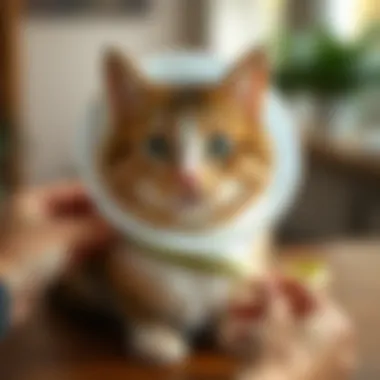
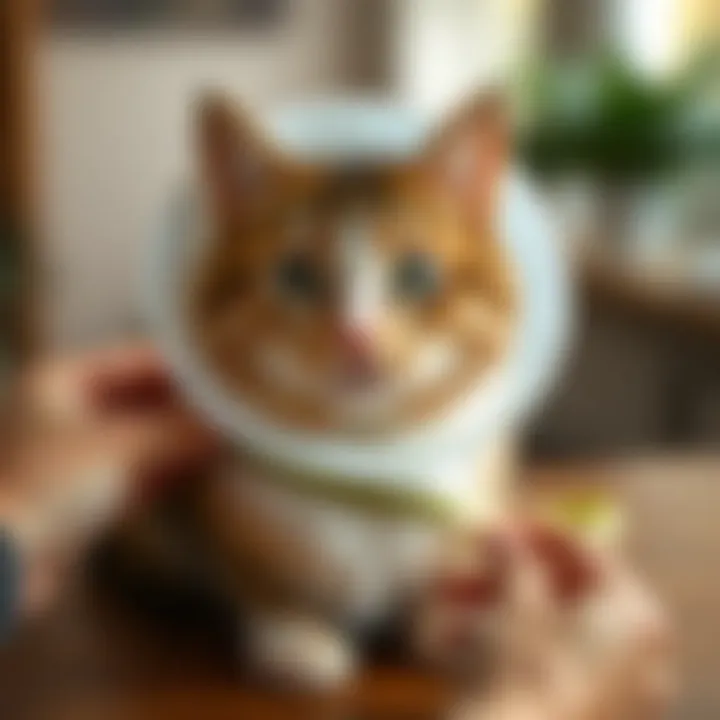
Pets are family, so it’s no surprise that many stores stock pet supplies. Soft cones can typically be found in a variety of settings, including:
- Pet Specialty Stores: Outlets like PetSmart or Petco usually have a range of soft cones tailored to different sizes and styles. This allows pet owners to physically check the product’s feel and fit.
- Online Retailers: Websites such as Amazon and Chewy provide an extensive selection of soft cones. The advantage here is the ability to read reviews from other cat owners, potentially guiding you to a better choice before hitting "Add to Cart."
- Veterinary Clinics: Often, vets recommend or sell recovery items directly. This can be a great way to ensure you’re getting a recommended product specific to your cat's needs.
- Local Pet Boutiques: Smaller local shops can provide unique options that might not be available in larger chains. Plus, supporting local businesses can have a positive impact on your community.
Each option has its pros and cons. While shopping in-store allows for immediate acquisition, online shopping can save you some pennies with discounts and variety. Either way, knowing where to purchase soft cones enhances your preparation and care for your cat.
Specific Offerings at PetSmart
When considering soft cones, PetSmart stands out as a key player for various reasons. This retailer not only focuses on your pet’s needs but also provides a range of features tailored to enhance comfort and wellbeing:
- Variety of Sizes: PetSmart offers a range of soft cones designed for cats of all sizes. Ensuring the correct size helps prevent discomfort and allows your cat to move freely, making the recovery process more bearable.
- Material Options: Unlike traditional collars, soft cones often come in materials that are soft and less abrasive. PetSmart stocks cones made from lightweight fabrics that are gentle on a cat’s skin, reducing irritation.
- Affordability: Pricing can vary, but generally, soft cones are reasonably priced at PetSmart. This makes it a viable option for pet owners on a budget.
- Expert Guidance: Employees are usually knowledgeable about pet care products. If you need assistance choosing the right cone or have questions about your specific cat’s needs, you can ask a staff member.
Ultimately, PetSmart combines accessibility with a solid commitment to pet health, making it a prime destination for purchasing soft cones. This level of service can make a world of difference when navigating the often overwhelming landscape of pet products.
Post-Surgery Care: The Role of Soft Cones
Soft cones play a significant role in the recovery process for cats post-surgery. Unlike traditional cone collars that can sometimes cause more discomfort than they alleviate, soft cones are designed to offer a better balance of protection and comfort. This section dives into how these innovative tools not only help your feline companions heal but also keep their anxiety in check.
Support During Recovery
After surgery, it is crucial for a cat to have a supportive environment that encourages healing. The soft cone helps create this environment by preventing the cat from reaching the surgical site. It acts like a guardian, ensuring that the stitches or healing wounds are safe from curious paws and eager tongues.
Moreover, soft cones are often made with materials that allow your pet to be cozy while wearing them. Because of the padded design, cats are less likely to feel confined or stressed, which can sometimes happen with rigid collars. The comfort provided can encourage your cat to relax and rest more, increasing the chance for a faster recovery. In fact, many pet owners report seeing their cats behaving more naturally, even while wearing a cone, thanks to this enhanced comfort.
- Benefits of Soft Cones in Recovery:
- Protects surgical sites without causing extra stress.
- Allows for natural movement and resting without interference.
- Encourages quicker healing due to lower anxiety levels.
Monitoring Behavioral Changes
Post-surgery recovery also involves closely watching for changes in behavior, which can be an indicator of mental and physical well-being. Cats might react differently when they are recovering; some may be more withdrawn, while others may appear unusually aggressive or agitated. This is where the role of the soft cone becomes even more vital.
Wearing a soft cone, the feline may exhibit different behaviors than when they are cone-free. By observing how your cat interacts with its environment—be it napping patterns or eating habits—you'll get an insight into whether your pet is adjusting well to the recovery process. Keeping a diary of behavioral changes can help provide your veterinarian valuable information for follow-up visits as well.
"Keeping an eye on your cat’s behavior is just as important as monitoring its physical healing. It can indicate how well they're coping with the changes they've faced."
In essence, soft cones provide not only physical protection but also psychological comfort. Paying close attention to how your cat fares while adjusting to wearing one can make a significant difference in its recovery journey. In summary, a soft cone serves as a beneficial tool in the aftermath of surgery, merging functionality with a compassionate approach to care.
Alternatives to Soft Cones
When it comes to ensuring a cat's comfort and safety, exploring alternatives to soft cones becomes essential. While soft cones have garnered attention for their numerous benefits, other recovery tools might be more suited for certain circumstances or individual feline temperaments. Understanding these alternatives can help pet owners make informed decisions tailored to their pets' specific needs.
Comparison with Other Recovery Tools
Several alternatives offer their own unique advantages, which could vary depending on the situation. It’s crucial to evaluate what each tool can provide. Here are some options:
- Elizabethan Collars (E-Collars): These classic, rigid collars resemble a lampshade and keep pets from reaching injuries or stitches. While historically common, they can impede mobility, leading to frustration in cats.
- Recovery Suits: These snug bodysuits are designed to cover a pet’s body, preventing them from accessing surgical sites while allowing for free movement and comfort. They’re made from breathable fabric and tend to be more aesthetically appealing. However, they may not be suitable for all types of wounds.
- Inflatable Collars: These collars are like an air-filled donut. They allow pets to see and move more freely compared to traditional E-collars but can sometimes slip off or not prevent access effectively.
It’s essential to consider factors like the type of surgery your cat has undergone and their overall behavior. Not all alternatives will work uniformly for every cat, so a thorough examination of each tool’s specific use is necessary.
Pros and Cons of Each Option
Each recovery tool has its strengths and weaknesses, and comparing them can shed light on what might work best for your pet’s recovery.
Elizabethan Collars
- Pros:
- Cons:
- Simple design
- Widely available
- Effective for keeping pets from licking wounds
- Can be uncomfortable
- Limits visibility and mobility
Recovery Suits
- Pros:
- Cons:
- Comfortable and allows for more mobility
- Easy to put on and take off
- May not cover all areas depending on the fit
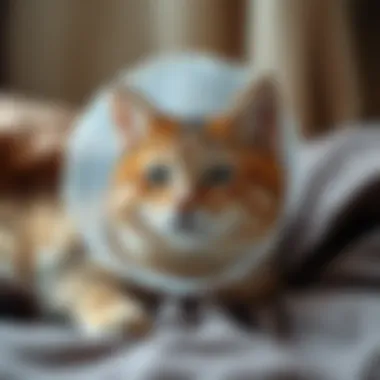
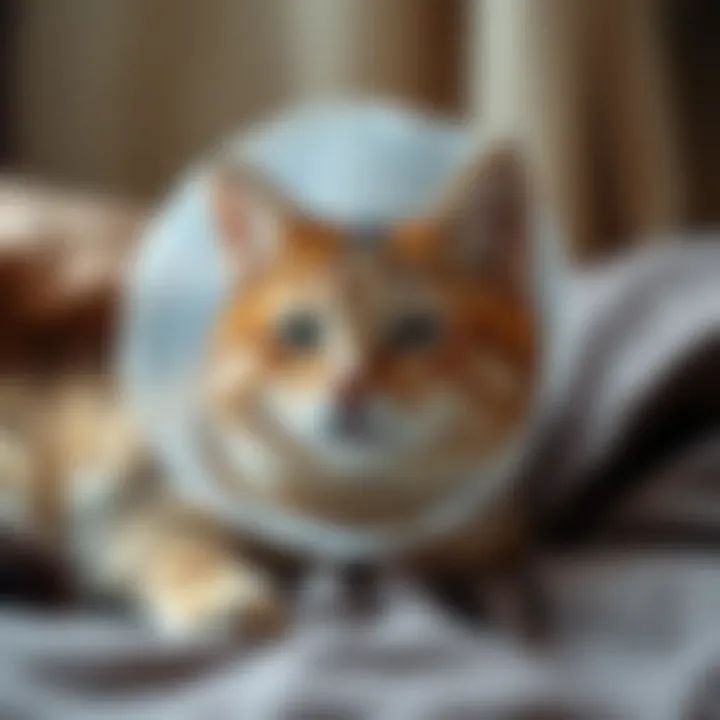
Inflatable Collars
- Pros:
- Cons:
- Greater comfort than hard collars
- Allows better peripheral vision
- Can be less effective for very determined cats
Understanding Cat Behavior with Soft Cones
When it comes to our furry companions, understanding their behavior is crucial, especially during recovery periods when they are facing discomfort or anxiety. The integration of soft cones into a cat's life is not just about protecting them; it's also about ensuring that they adapt smoothly to temporary changes in their everyday experience. This section sheds light on the behavioral aspects of cats when they wear soft cones, providing insight into both the benefits and the challenges that arise.
Adapting to the Cone
Adapting to a soft cone can be a mixed bag for many cats. Some may take it in stride, while others might respond with surprise or frustration. A soft cone is designed to be less intrusive than traditional collars, yet it still alters a cat's field of vision and mobility. Here are some important considerations about how cats adapt to these protective aids:
- Familiarization: Introducing the cone gradually can ease a cat into the experience. Let them sniff the cone and explore it. Use treats or their favorite toys to create a positive association.
- Comfort Level: Monitor their reactions once the cone is on. If the cat is constantly pawing at it or appears distressed, it may be necessary to adjust the fit or check their comfort level with the material.
- Encouragement: Offer encouragement through gentle voices or reassurance. Cats are perceptive; they often take cues from their owners. A calm presence can help them feel more at ease.
Bringing home a soft cone might seem like a straightforward decision, yet fostering a cat's comfort within it often requires patience and sensitivity.
Common Reactions and Solutions
As with any new experience, the reactions to wearing a soft cone can vary significantly among individual cats. It’s essential to recognize these reactions and respond effectively. Below are some common responses and potential solutions:
- Refusal to Move: If a cat suddenly plops down and refuses to walk, it’s not uncommon. This could stem from unfamiliarity or discomfort with the cone’s restrictions. Solution: Make their environment more inviting. Set up cozy resting spots to encourage them to relax comfortably.
- Increased Grooming Attempts: Some cats may still try to reach the areas they usually groom, despite wearing a cone. It’s a natural instinct. Solution: Keep an eye on them. If they seem frustrated, redirect their attention with interactive play or distractions.
- Acting Out: A few cats may show signs of irritability or aggression, partly due to the stress of wearing a soft cone. Solution: Give them space when needed but also the comfort of companionship. During the convalescence period, spend time nearby. Every little bit helps reassure them.
"It's important to remember that patience is key. A soft cone is a tool for healing; understanding your cat's reactions can turn a frustrating experience into an opportunity for bonding and care."
Expert Insights on Choice and Use
Selecting the right recovery tool for your feline friend isn’t just about aesthetics; it’s a careful consideration driven by both the physical and emotional needs of your cat. Understanding these nuances is essential, and that’s where expert insights come into play. Vets and behavioral specialists offer valuable perspectives that can greatly influence your decisions and overall approach to post-surgical care.
Veterinarian Recommendations
Veterinarians are on the frontline when it comes to tacking pet health issues, and when it comes to soft cones, their recommendations are based on clinical experience and animal welfare.
- Comfort and Fit: Vets emphasize that a soft cone should fit snugly but not too tight. If there’s too much pressure, it could cause discomfort. A cone that’s just right will not only keep your cat from reaching wounds but also allow them some wiggle-room.
- Material Matters: Many vets suggest opting for soft cones made from breathable fabrics to prevent skin irritation. Not only does this promote healthier skin, but it also keeps the recovering pet more comfortable.
- Duration of Use: Another useful bit of advice is around the duration the cone should be worn. Many veterinarians generally recommend using it as directed, often for at least 7 to 14 days post-surgery. However, every pet is unique; the recovery time can vary significantly based on the type of procedure and the individual cat’s healing process.
With these aspects considered, it’s essential to consult your vet for tailored advice based on your cat’s specific needs. They can suggest which brands have proven effective and which styles may work best given your pet’s personality and habits. A soft cone should facilitate healing, not create additional complications.
Behavioral Specialists’ Perspectives
Behavioral specialists contribute another layer of understanding when it comes to managing a cat’s transition into using a soft cone. Their insights focus more on how your feline friend might react and what you can do to ease any anxiety or behavioral adjustments.
- Gradual Introduction: They often recommend introducing the cone gradually. Let your cat sniff and explore the cone before requiring them to wear it. This mitigates feelings of fear or sudden change, which could lead to stress and anxiety.
- Behavior Monitoring: Keeping a keen eye on your cat’s behavior while using the cone is essential. If a cat becomes excessively agitated or attempts to remove the cone, it may indicate discomfort or an incorrect fit. Behavioral specialists may provide recommendations on how to adjust the cone or modify your cat's environment to make it more comfortable.
- Positive Reinforcement: Engaging your cat with treats or toys while they wear the cone might help them associate positive experiences with it. This could mitigate any behavioral issues stemming from stress or anxiety.
"Managing a cat's comfort and emotional health during recovery is just as crucial as addressing their physical condition."
In essence, both veterinarians and behavioral specialists emphasize a holistic approach when it comes to soft cones. Their expert insights not only inform proper usage but also shape how you navigate the recovery process, making it smoother for both you and your beloved pet.
Finale: Making Informed Choices for Your Pet
When it comes to caring for your feline companion, making informed decisions is paramount. In this article, we have delved into the myriad aspects of soft cones for cats, from their design evolution to specific care instructions. Understanding soft cones is not just about knowing what to buy; it's about ensuring the wellbeing of your pet during recovery periods or when they’re under various types of stress.
Here are a few key takeaways to keep in mind:
- Comfort Matters: Opting for soft cones can greatly enhance your cat's comfort. Traditional collars might be effective, but they can often restrict movement and provoke anxiety. Cats are inherently creatures of comfort, and a soft cone often aligns more closely with their needs.
- Choosing the Right Fit: Not all soft cones are created equal. Picking the right size and material can significantly affect how well the cone will perform. Ensure you assess your cat's specific needs, as every feline is different.
- Post-Surgery Recovery: Paying attention to your cat post-surgery is crucial. Soft cones can aid in a smoother recovery process, allowing them to heal without the risk of aggravating their wounds.
- Monitoring Behavior: Cats may have different reactions to wearing a soft cone. Keeping an eye on their behavior allows you to make necessary adjustments.
In essence, the benefits of using soft cones extend far beyond aesthetics; they are instrumental in promoting a restful recovery journey. Armed with information, you can make educated choices that balance both effectiveness and comfort for your pet.
Summarizing Key Points
In summarizing the discussion around soft cones for cats, it's clear that the holistic understanding of this product is vital for responsible pet ownership. Remember to consider the following:
- The key advantages of soft cones over traditional options
- Factors relating to fit and materials that contribute to your cat’s comfort
- The potential psychological impact on your pet, especially during recovery
- Importance of monitoring and adjusting based on your cat’s behavior during the recovery process
The overall aim should always be to create a safe and supportive environment for your cat.
Encouraging Responsible Pet Ownership
Encouraging responsible pet ownership begins with educating yourself about the products you choose for your pets. In the case of soft cones, a deeper understanding can go a long way in transforming your cat's recovery experience. It is essential to:
- Stay Informed: Knowledge is power. Read up on various recovery tools and consult your vet for personalized advice. Websites like PetMD and The Humane Society offer valuable insights.
- Prioritize Comfort: Always aim to choose products that put your pets’ comfort first. Soft cones are designed to provide a better fit, reducing distress and allowing for normal activities, such as eating and drinking.
- Share Experiences: Engaging in discussions with fellow pet owners can provide a wealth of shared knowledge. Platforms like Reddit can be helpful in feathering out practical experiences.
- Regular Vet Checkups: Regularly consulting with vets can help in making informed choices about not just soft cones, but overall pet health.
Ultimately, knowing what to choose and how to use it is part of being a responsible pet owner. It stretches beyond the monetary aspects and taps into the emotional welfare of our furry friends.















